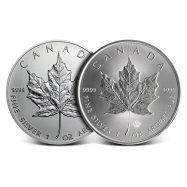

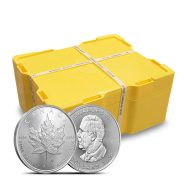


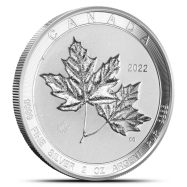


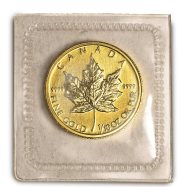




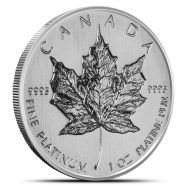
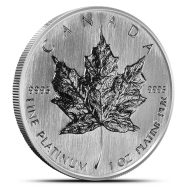

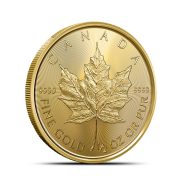



The Royal Canadian Mint (RCM) is Canada’s official government mint and one of the world's most prestigious coin and bullion producers. While some people are more intimately familiar with the U.S. Mint than the RCM, both these organizations are innovators and bona fide leaders in coin production.
Since 1969, the RCM has been a Crown corporation. A crown corporation is a type of entity unique to Canada and possesses certain qualities of a governmental organization and a private business. As such, the RCM reports to Canada’s Ministry of Finance.
The RCM is responsible for producing all of Canada’s coinage, including the six standard production coins (5¢, 10¢, 25¢, 50¢, $1, and $2), as well as the nation’s bullion coins–like the famed gold and silver Canadian maple leaf.
As a former colony of England, Canada didn’t get its mint until the founding of the Royal Canadian Mint in 1931. Before Canada’s founding, Canada’s coins came primarily from the Royal Mint of London. This wasn’t unusual – other English colonies, including Australia, New Zealand, and Zimbabwe, mostly used coins shipped over the ocean from London before opening their own mints.
In 1908, the first Canadian coin stamped with a ‘C’ was minted at the Royal Mint’s Ottawa branch. In addition to minting all of Canada’s coins, the Royal Canadian Mint has also been contracted to produce coins for nearly 100 other countries, including the U.S., Mexico, China, Spain, Argentina, New Zealand, and many more. This isn’t an unusual practice – many nations simply don’t have the infrastructure to support their own government mints. Others find it more economically sensible to pay for world-class service than to try to recreate RCM’s services domestically.
Today, the Royal Canadian Mint has two branches – Winnipeg and Ottawa – producing roughly two billion Canadian coins each year.
The RCM makes dozens of bullion products but is best known for the Canadian maple leaf. Besides the maple leafs, some of the RCM’s bullion products are 1/4 oz bullion gold Great Horned Owl, the 1 oz Klondike Gold Rush coin, and the gold and silver Kermode Spirit Bear.
Many of Canada’s bullion coins pay homage to the nation’s unique, diverse wildlife with special coin series releases, including:
 1 oz Gold Call of the Wild Series (Bobcat, Golden Eagle, Roaring Grizzly, Howling Wolf, Growling Cougar)
1 oz Gold Call of the Wild Series (Bobcat, Golden Eagle, Roaring Grizzly, Howling Wolf, Growling Cougar)While gold and silver are the most popular metals used by the RCM for bullion coins, the Canadian maple leaf has been produced during specific years in platinum and palladium, too.
 The star of the Royal Canadian Mint’s lineup is the Canadian maple leaf. Created by former Chief Engraver of the Royal Canadian Mint, Walter Ott, the gold Canadian maple leaf (like the gold American eagle) was originally conceived as an alternative to the famous gold South African Krugerrand. The Canadian maple leaf was first minted in 1979 as a 1 oz pure gold coin featuring Queen Elizabeth II of Canada on the obverse and the eponymous maple leaf on the reverse.
The star of the Royal Canadian Mint’s lineup is the Canadian maple leaf. Created by former Chief Engraver of the Royal Canadian Mint, Walter Ott, the gold Canadian maple leaf (like the gold American eagle) was originally conceived as an alternative to the famous gold South African Krugerrand. The Canadian maple leaf was first minted in 1979 as a 1 oz pure gold coin featuring Queen Elizabeth II of Canada on the obverse and the eponymous maple leaf on the reverse.
1982 brought a new and improved gold maple leaf boasting the world’s first 99.99% purity gold coin and the addition of 1/4 oz and 1/10 oz sizes. Since 2014, RCM has produced several fractional weights annually, including 1/2 oz, 1/4 oz, 1/10 oz, 1/20 oz, and even 1 gram gold maple leaf coins.
By 1988, the RCM began issuing special 10 oz silver maple leaf coins in commemoration of the maple leaf's 10th anniversary. Since then, the silver maple leaf has only been produced in its current 1 oz denomination.
From 1988 until 2002, the RCM also made 99.95% platinum maple leaf coins, which were available in various denominations from 1 oz, 1/2 oz, 1/4 oz, and 1/10 oz. 1993 brought the addition of a 1/20 oz platinum maple leaf, followed by a single year (1994) where a 1/15 oz version was sold. Since 2009, however, the platinum maple leaf has only been produced in a 1 oz size.
In 2005, the palladium maple leaf joined the thriving series as its newest member. The palladium maple leaf was produced for three years before taking a one-year interlude, followed by another year of production in 2009 and a six-year hiatus, after which the coin was reintroduced in 2015. Like the platinum maple leaf, the palladium maple leaf is 99.95% purity, and today is only available as a 1 oz coin.
 Twin Maples
Twin MaplesA relative newcomer to the RCM’s bullion collection, the Canadian twin maples are the Canadian maple leaf’s successors. At 99.99% pure gold, the Canadian twin maples are every bit as fine as the original maple leaf coin. First introduced in 2017, the Canadian twin maples feature Queen Elizabeth II on the obverse and a pair of Canadian sugar maple leaves on the reverse. Canadian twin maples come in 2 variations – a 1/4 oz gold twin maple leaf coin and a 2 oz silver twin maple leaf coin. Both have a $10 face value, are minted in limited numbers annually, and are IRA-eligible bullion coins.
The Royal Canadian Mint is regarded as a leader in both coin technology and security. RCM coins can contain over half a dozen high-tech features like micro-engraving, edge lettering, multi-ply plating electromagnetic signatures, laser marks, virtual images, and more. RCM coins are made with quality, durability, and sustainability in mind, utilizing RCM SMaRT technologies to prevent tarnishing and wear. Even so, because gold maple leaf coins are minted in pure gold, they’re extremely easy to scuff, scratch, or otherwise damage, so you should always handle them with care.
On its bullion coins, the RCM implements even more cutting-edge technology features. One of the distinguishing features of the Canadian maple leaf is its radial line finish, which demonstrates an incredible level of machine precision. RCM technology also includes laser marks and images encrypted with special codes stored in the RCM Bullion DNA database, used for authentication.
The RCM makes it easier and safer than ever for approved dealers to quickly authenticate maple leaf coins using the Bullion DNA device. The Bullion DNA device scans a coin and matches the photo to the RCM database, instantly showing whether or not the coin is registered with the Mint.
much-deserved respect and recognition. As a refiner, the RCMis capable of achieving a fineness unrivaled by almost all other mints. In addition, the RCM has strict quality control measures, like weighing each coin multiple times at different stages of the production process.
Besides producing some of the finest bullion products available, Royal Canadian Mint coins are among the most secure and innovative coins. Investors can enjoy the peace of mind that the anti-counterfeit features of the Canadian maple leaf coin bring, as well as the thoughtful manufacturing process that makes these coins among the most easily authenticated, counterfeit-resistant, and secure in the world.